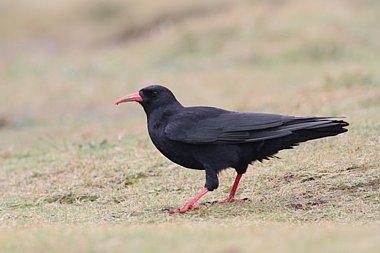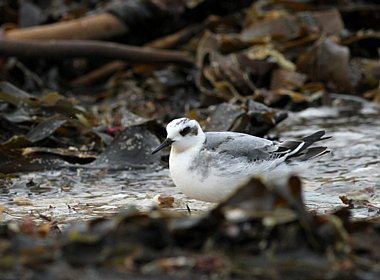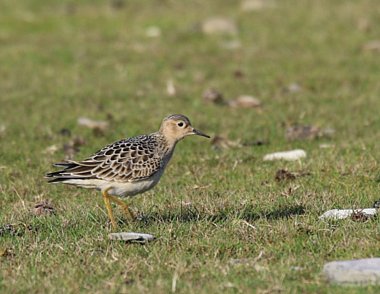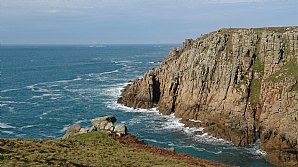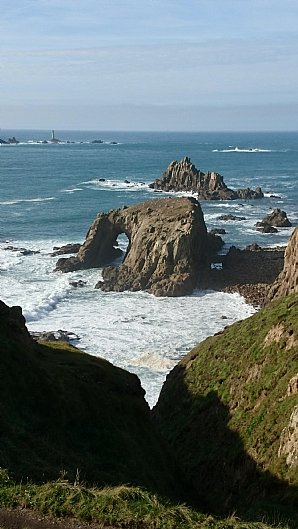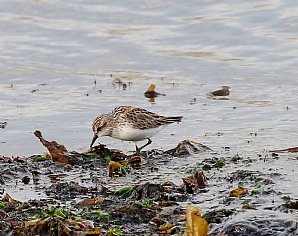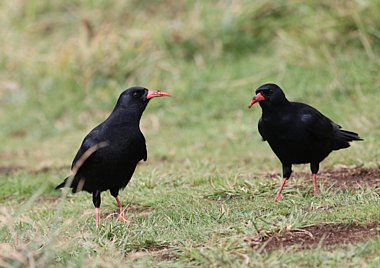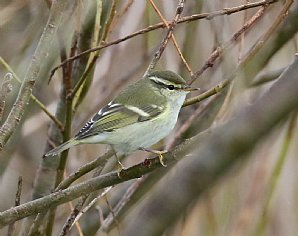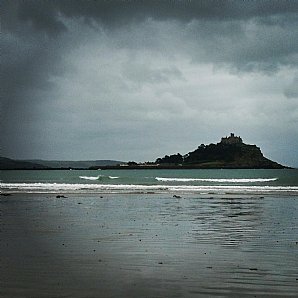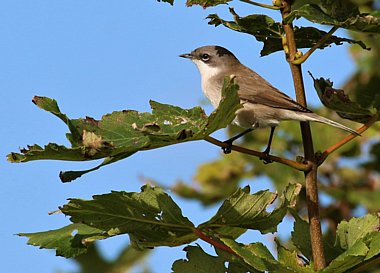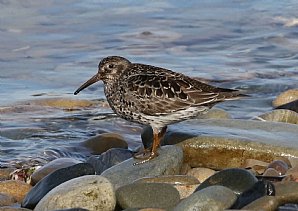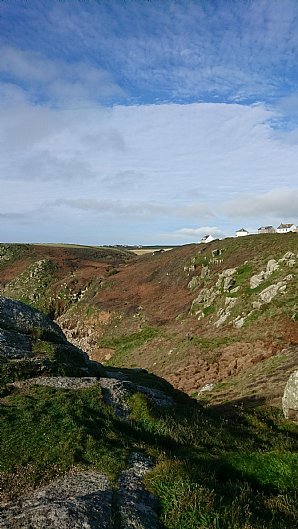West Cornwall in Autumn for birders
Exciting autumn migration and rarity hunting
| Destination | |
|---|---|
| Focus | |
| 2025 Dates | |
| Duration | 8 Days |
| Guides | |
| 2025 Price | £1945 pp £130 single supplement. Deposit £300 |
| 2026 Dates | |
| Duration | 8 Days |
| 2026 Price | £1945 pp £150 single supplement. Deposit £300 |
| Max Group Size | 7 |
West Cornwall is a birders' playground, with a strong reputation as one of the best British birding counties in autumn. The Penwith peninsula at the ‘end of the land’ is ideally placed as a filter for southbound migrants and rarities, and with beautiful valley habitats and rugged coastline, it’s one of the great places for birdwatchers to explore. October is one of the best times to visit and extensive knowledge of all the birding hot-spots, plus some hidden gems will give us a great chance to enjoy migration over both land and sea. Our daily schedule will be flexible, planning days around local, up to date bird news and of course the weather. Based in the far west we shouldn’t need to travel much either, with great sites such as Porthgwarra, Cot Valley, Nanquidno, Hayle, Marazion and Drift nearby there’s great birding on our doorstep, and we plan to visit the Lizard Peninsula where Choughs famously first made their return to the county.
Species possibility is broad depending upon luck and the prevailing weather. Birds vary every year, but Africa-bound passerines including a variety of warblers, Redstart, Wheatear, Pied and Spotted Flycatcher should be encountered, along with Firecrest, Black Redstart and migrant finch, lark and pipit flocks. We might find our own Wryneck, Red-backed Shrike, Red-breasted Flycatcher or perhaps something even rarer from the east. Winds from the west might yield an American wader or something really 'mega', recent examples being Grey Catbird, Red-eyed Vireo, Hermit Thrush, Yellow-billed Cuckoo and Britain’s first Alder Flycatcher. Sea-watching can be excellent, and our boat trip into Mount's Bay will give great views and possibly cetaceans too. Exciting birding, relatively warmer weather and great coastal scenery in a massively under-watched part of the UK!
We have timed this holiday so it may be combined with our Isles of Scilly for birders trip for the ultimate south-west birding experience!
Please note this holiday starts and ends in Penzance
Day 1: Friday - Arrival, meet up and Marazion Marsh
We meet at Penzance station at 13:30, or at our accommodation at 14:00 if travelling by car. You can leave your vehicle parked here for the duration of your holiday. Please contact our office for travel tips by road, rail and air. Once gathered and settled into our comfortable accommodation, we head straight out birding to make the most of the day. We’ll start close to base, visiting local sites, target a rarity or have an early visit to the excellent Marazion Marsh RSPB reserve near Penzance. This wetland site is super for wildfowl and waders, and Little Egret and Kingfisher are likely to get us off to a good start. Cetti’s Warbler are resident in the reed-beds and a walk through the reserve and into other scrubby areas should add other migrant warblers plus Reed Bunting. We also plan to visit adjacent Mount’s Bay with majestic St Michael’s Mount as a backdrop. The beach can be especially productive, flocks of Ringed Plover, Dunlin, Turnstone and Sanderling often harbouring Little Stint and Curlew Sandpiper. Migrant Wheatear, Rock Pipit, White and Yellow Wagtail feed in the tide wrack, with hirundines likely to be seen over both the marsh and seaweed areas. A great place to start!
Day 2: Saturday – Porthgwarra and St Levan
We head to the valleys starting at Porthgwarra, the most south-westerly point in mainland Britain, and a famed birdwatching site with an excellent track record for rarities. We will search the area extensively for migrants, checking patches of trees and bushes in the “60ft cover”, around the “Doctors Garden” and up on the moorland. Passerines such as Skylark, Meadow Pipit, wagtails and finches should be numerous with African bound migrants including Whinchats, Redstarts, Pied or Spotted Flycatchers, and a range of warblers likely. Firecrest are regular and scarce species recorded annually include Wryneck, Melodious, Barred and Yellow-browed Warbler, Red-breasted Flycatcher, Common Rosefinch and Serin. A mouth-watering array of Nearctic rarities have occurred in this famous valley in recent years including Red-Eyed Vireo, Yellow-billed Cuckoo and Hermit Thrush, while Brown Shrike, Syke's, Radde’s and Dusky Warbler are just a few examples of eastern origin. Will we get lucky? The possibilities are endless!
Sea-watching can be exceptional too and if conditions are favourable we’ll spend time watching birds passing the legendary Runnelstone Buoy. We should see a range of seabirds with Gannet, Fulmar, Guillemot and Razorbill abundant. Balearic and Sooty Shearwater are both often commoner than Manx at this time of year, with Great and Cory’s Shearwater, European and Leach’s Storm Petrel, all four skuas, Grey Phalarope and Sabine’s Gull among the rarer possibilities. Cetaceans including Harbour Porpoise, Common and Bottlenose Dolphin are also often seen regularly. Depending on conditions, we may head over to nearby St Levan or Porthcurno valleys, or to work the fields around Polgigga or Treen.
Day 3: Sunday – Land’s End and Sennen
Land’s End is not just a tourist attraction, it’s one of the best birding locations in the country! Coastal bushes and scrubby cover is sparser here than in the valleys, and it is one of the best places in Britain to watch visible migration as birds pour out to sea, not making landfall again until France or even Spain. A day to really find our own birds, we explore the habitat thoroughly searching for freshly arrived migrants in the willow bushes, Cornish hedgerows and fields. The cycle path allows for easy walking and is the best place for a Wryneck. It also offers a good vantage into the fields for pipits, Yellow and White Wagtail, while the short cropped turf of the coast path is attractive to Wheatear, Black Redstart, Stonechat and Chough.
Just inland lies the village of Sennen and more great birding habitat. Rare pipits are something of a speciality of the whole area - Richard’s is regular, while Blyth’s, Tawny, Buff-bellied, Red-throated, Olive-backed and famously Britain's first Paddyfield Pipit have all been recorded in recent years. The lack of cover may not always suit rare warblers but regular coverage has unearthed Paddyfield, Syke’s, Western Bonelli’s, Sardinian, Subalpine, Melodious, Radde’s and Dusky Warbler in the past, so high quality birding is very possible. A magnet for shrikes too, Red-backed and Woodchat are the most regular hereabouts, and Britain’s seventh Turkestan Shrike and tenth Brown Shrike occurred here; both found by Heatherlea Guide Mark Warren! In the evening we can perhaps consider visiting Bartinney Downs or Mên-an-Tol for the Hen Harrier roost. We might see Barn and Short-eared Owls too while Merlin take advantage of an abundance of prey at this time of year.
Day 4: Monday – Boat Trip & Hayle Estuary
This morning, we head to Penzance to take a wildlife boat trip, which will of course be available subject to weather conditions. As we board, we look out for Purple Sandpiper among the Turnstones at the harbour before heading out into Mount's Bay. We travel west, gaining a different perspective of the stunning Penwith coastline and iconic open-air Minack Theatre, and once clear of Porthgwarra will continue a few miles towards the famous runnelstone, though our exact route is of course weather dependent and the decision of the skipper. We should see a range of seabirds and views can be excellent. Gannet, Fulmar, Guillemot and Razorbill should be plentiful, and Balearic Shearwater and a few Puffin are usually around at this time of year. Also possible are Manx, Sooty, rarer Great and Cory’s Shearwater, European and Leach’s Storm Petrel, skuas, Grey Phalarope and Sabine’s Gull. Cetaceans including Harbour Porpoise, Common and Bottlenose Dolphin are seen regularly with the chance of other species or a late Basking Shark, the peculiar Sunfish of even Atlantic Blue Fin Tuna – a great morning on the sea!
Back on dry land we move over to the Hayle Estuary RSPB for the afternoon. The most important site for wildfowl and waders in the area, many thousands of birds feed on the tidal mud. Wigeon and Teal will be the most numerous of the ducks with Curlew, Bar-tailed Godwit, Dunlin, Knot and Redshank the commoner waders. Rarer species as always are possible but if not, Little Egrets will entertain while the low tide gull roost can serve up thousands of birds and a good scan might yield a Yellow-legged Gull or any late tern. There’s lots of vantage points and sites to birdwatch from but if we still have time to spare we’ll visit nearby Gwithian or the pools at St Gothian Sands to finish the day.
Day 5: Tuesday – St Just and nearby valleys
The sheltered valleys situated right next to this former mining town will give us another chance to seek out resting passerines. Nanquidno, Cot, Kenidjack and to a lesser extent Kelynack are all well known by birding reputation, and we enjoy our time birding and walking in these beautiful areas. Firecrest and Yellow-browed Warbler will be top targets again among commoner warblers and land birds. The calls of overflying Chough and Raven will draw our gaze skywards and away from the bushes from time to time. The local Golden Plover flock often contains other waders such as American Golden Plover, Buff-breasted Sandpiper or Dotterel. We have already seen Red Eyed Vireo in this area on a previous tour, and with luck and the right conditions could get lucky again - a repeat of Britain’s first and only Yellow-throated Vireo, or an American Redstart, Northern Parula or Blackpoll Warbler would do nicely!
Day 6: Wednesday – The Lizard
A day trip to the most southerly point in Britain and the area where Choughs first returned in 2001 to re-claim their traditional territory, as featured on the Cornish coat of arms. Practically guaranteed on the Lizard we should see this smart member of the crow family and visiting the sheltered valleys and bays at Kynance, Caerthillian or Church Cove could give us migrants. Open ground and coastal scrub at Bass Point can be one of the better sites for Dartford Warbler, and sea-watching has yielded some great sightings over the years in favourable conditions. Windmill Farm LNR and farmland around the village itself also offers great birding and there’s lots of potential in a relatively small area. Sympathetic farming practices ensure good numbers of finches are present and any Linnet or Goldfinch flock will be worth checking. Golden Plover, Lapwing and Curlew also feed in the fields, and raptors will be on the lookout for an easy meal. We could also visit Stithians Reservoir on this day if something good has been reported, or take the chance to try under-watched sites such as Prussia Cove or the Tresillian River on our way home.
Day 7: Thursday – Drift, Pendeen, Northern Valleys
Cornwall really does offer a bounty of birding sites and range of possibilities. If we haven’t yet visited Drift Reservoir we may do so today, this new freshwater habitat potentially adding a number of new species. Great Crested and Little Grebe are likely as are diving ducks such as Tufted Duck and Pochard. Muddy inlets give us the best chance of freshwater waders such as Greenshank and Common and Green Sandpipers or maybe a late Osprey. A walk to the hide might add a Kingfisher, and Dipper sometimes show from the dam. American waders such as Pectoral Sandpiper and Lesser Yellowlegs have been recorded numerous times as has Ring necked Duck and Lesser Scaup. If the wind is strong and from the north or west then sea-watching from Pendeen is definitely worthwhile. From a sheltered position by the lighthouse wall, Gannet, Kittiwake, shearwaters, and skuas can pass just under the cliffs, and it’s the best place in the county to observe Leach’s Petrel, Sabines Gull and Grey Phalarope in the right conditions. We may decide to explore neglected valleys on the north Penwith coastline or venture further into north or east Cornwall for any rarities on offer – will we find that big American rarity and put a new Cornish site on the map!
Day 8: Friday - Final birding and depart
Our final day and the chance to mop up on any species we might not have connected with. With migration in full swing a visit to any of the already visited headlands, valleys, reservoirs, beaches, estuaries, plantations or sea-watching sites could yield a completely new set of species. Exact plans for the day will be based around clients travel arrangements but we’ll be sure to get as much birding in as possible to conclude our time in Cornwall.
Please note: all itineraries are given as a guide only. Actual holiday content may vary according to the judgement of your guide, and elements beyond our control (eg weather).
What's included in your 'West Cornwall in autumn for Birders' holiday price
• Seven nights comfortable en-suite hotel accommodation. Guests are never expected to share. All rooms are en-suite. Full details with your joining pack.
• Full breakfast and dinner from Friday evening until Friday morning, packed lunch daily.
• A wildlife boat trip.
• Guidance from a professional Group Leader.
What's not included in your 'West Cornwall in autumn for Birders' holiday price
• Travel to Penzance
• Insurance, drinks and other items of a personal nature.
Other Info:
Expect a wide variation in weather conditions. Cornwall can be wet and windy, however we may also experience some warm weather. Sunshine, rain and strong winds are all possible, and you will probably experience a bit of everything. Please bring walking boots or shoes, weatherproof clothing and a small rucksack.
We are often on our feet for most of the day on this holiday. We take things at a slow pace, though will cover quite a few miles of walking over rough or uneven coastal paths and through fields or across sandy beaches each day. Our excursions are usually on good trails, though rare birds are often found in inconvenient locations, involving several gates and stiles to be climbed or long walks in exposed locations, often peering down gullies and into ditches. Please note that although there is a vehicle on this tour a reasonable level of fitness is essential. You may find a walking pole useful!
Other birding and wildlife holidays in Southern England
- Isles of Scilly for birders
- Cornwall in Spring
- Forest of Dean and Somerset Levels
- Isles of Scilly in Spring
- NEW! Winter Birdlife of Devon & Dorset
Why choose Heatherlea for your birding and wildlife holiday?
Heatherlea is one of Britain's leading wildlife holiday operators. In 2019 we celebrate our 29th Anniversary with more choice than ever, both in Scotland and overseas. Relax and enjoy yourself, as we do all the planning! Above all, we make it our business to show key wildlife to you. Our fully inclusive guided holidays concentrate on the real experience, and we take time to ensure that each of our guests enjoys everything we do.
- We have been organising birding and wildlife holidays for 30 seasons, and have a highly experienced and capable office team. We also offer a telephone and email service outside normal office hours.
- We are a small company, run BY birders FOR birders. Come and see!
- Heatherlea are Mainland Scotland’s FIRST ‘5-Star Wildlife Experience!’ This is the highest available grading, classified as ‘exceptional’ by visitScotland.
- Heatherlea hold full Tour Operator Insurance for your added protection.
- Heatherlea is a limited company, registered in Scotland. We are also registered to pay VAT, which is included in your holiday price as quoted on this page.
- Once your holiday is confirmed in writing by us, we promise not to surcharge the price for any reason.

